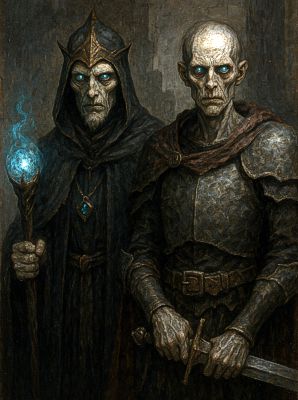The draining of the undead can have terrible repercussions indeed. Those that die may rise themselves as the living dead, while those
that survive may be crippled for life, and not all handle it that well. The wightlord is a sad example of the corruption which can be caused by
an undead’s attack.
Although still alive, wightlords look like mere pale reflections of their original self, their skin almost translucent and drawn tight over their
bones, an eerie light shining in their eyes. It is easy to take a wightlord for one of the more common undead, but for most people this is their
last mistake, as is proven when the wightlord releases his powers upon the unsuspecting souls.
Wightlords speak all the languages they knew before their transformation.
Combat: The powers of wightlords vary depending on their former lives. Those who were warriors may have proficiency with the
sword, while the arcane may wield the magic spells they knew in life. A mage wightlord’s level varies depending on the wightlord’s past. However,
no wightlords lower than 9th level have as yet been encountered, and regardless of their profession, all wightlords use the standard monster
Hit Dice (d8) to determine hit points.
All wightlords have a chilling touch that causes 1d8 hit points of damage. This touch drains a victim’s life force, adding the lost hit points
to that of the wightlord (though never over his maximum). No save is allowed, and in addition to the hit point loss, the touch drains one level,
though the victim does not lose additional hit points for the latter. When the last level is drained, the victim dies, rising within three hours
as a wight or wraith under the wightlord’s control. No levels are drained if the wightlord
employs a weapon, but those who know the arcane arts can extend the ability through spells like vampiric touch.
The wightlord is not undead, and can not be turned or harmed with holy water, nor can detect undead detect a wightlord. They do have a few
undead-like immunities, though. They are immune to the draining attacks of other undead or wightlords, and to death magic and cold based
spells, though charm spells and poisons still work.
The attack form of a wightlord varies depending on its past. Warriors will prefer to use their draining attack, while magic users or priests
will try to use their spells to gain the upper hand.
Some wightlords can be coerced into reason and negotiation, but most are insane beyond reason, as the negative energies slowly consume the lord’s
mind.
Habitat/Society: Unless a wightlord has a way to hide his nature, he will generally out to live outside of society, spending his
days as a hermit, until those times when his insanity drives him to seek out victims to ease his frustrations. Most warrior wightlords quickly
go insane, taking their vengeance on the society that is now unable to accept them.
Mage wightlords are more capable of dealing with their condition, and sometimes can grow to become powerful spellcasters, often well versed in
the field of necromancy.
Most lords eventually seek out the company of the undead, feeling particularly drawn to the creatures that caused their condition in the first
place, such as wights or wraiths.
Ecology: A wightlord is sometimes created when a high-level (9th or higher) warrior or mage barely survives an undead draining
attack, most often when under a powerful protecting charm. Nobody really knows why certain people become wightlords, while others are crippled
for life. Most mage wightlords were necromancers, but not all of them—at least one diviner is known to have been turned into a wightlord. Some
speak of wightlords as Greater Cold Ones
, but the powers of a wightlord are far beyond those poor souls.
It is speculated that the dark powers have a hand in this, tempting heroes with undead powers they cannot control. Indeed, it seems only
Ravenloft can spawn a wightlord, and their number is so small that it is seen as an indication that the personal intervention of the dark
powers is involved. Still, some wightlords seem to hang on to their own alignments for quite a while, and it is speculated that for those
few a wish or restoration can bring the wightlord back from the darkness.
By Liederick


